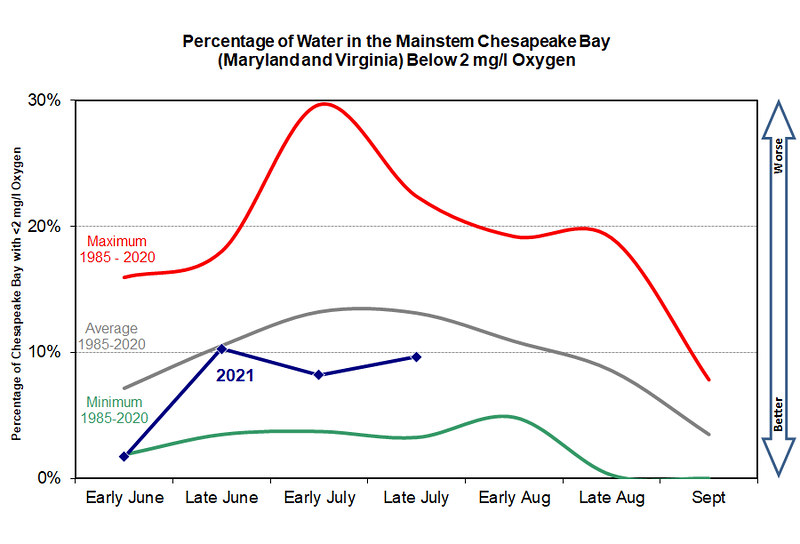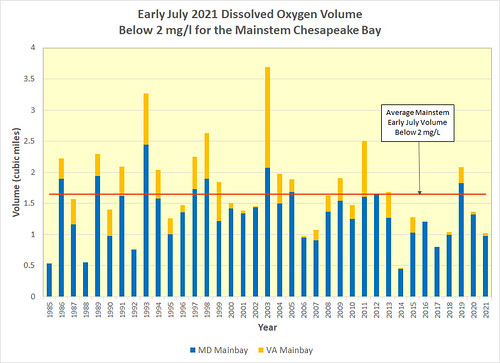Dissolved Oxygen Conditions Remain Better than Average Through July
 Data collected by the Maryland Department of Natural Resources (DNR) and Old Dominion University show that dissolved oxygen conditions in the Chesapeake Bay mainstem of Maryland and Virginia continued to be better than average in July. The hypoxic water volume — areas with less than 2 mg/l oxygen — was 1.02 and 1.20 cubic miles during early and late July monitoring cruises, compared to historical early and late July averages (1985-2020) of 1.64 and 1.63 cubic miles. The early and late July reports rank as the 7th and 8th best in their respective time periods, out of a total of 37 years of monitoring. The effects of Tropical Storm Elsa were not captured in July’s monitoring, as early July sampling occurred just prior to the storm passing through the Bay watershed.
Data collected by the Maryland Department of Natural Resources (DNR) and Old Dominion University show that dissolved oxygen conditions in the Chesapeake Bay mainstem of Maryland and Virginia continued to be better than average in July. The hypoxic water volume — areas with less than 2 mg/l oxygen — was 1.02 and 1.20 cubic miles during early and late July monitoring cruises, compared to historical early and late July averages (1985-2020) of 1.64 and 1.63 cubic miles. The early and late July reports rank as the 7th and 8th best in their respective time periods, out of a total of 37 years of monitoring. The effects of Tropical Storm Elsa were not captured in July’s monitoring, as early July sampling occurred just prior to the storm passing through the Bay watershed.

 Additionally, in early and late July, within Maryland’s portion of mainstem hypoxic waters, 0.27 and 0.45 cubic miles were anoxic — areas with less than 0.2 mg/l oxygen, following an anoxia volume of 0.26 cubic miles in late June 2021.
Additionally, in early and late July, within Maryland’s portion of mainstem hypoxic waters, 0.27 and 0.45 cubic miles were anoxic — areas with less than 0.2 mg/l oxygen, following an anoxia volume of 0.26 cubic miles in late June 2021.

 Beginning this year, combined results for Maryland and Virginia are being presented for the mainstem Bay, to be more comparable to the yearly seasonal forecast by the U.S. Environmental Protection Agency’s Chesapeake Bay Program, U.S. Geological Survey, University of Maryland Center for Environmental Science, and University of Michigan.
Beginning this year, combined results for Maryland and Virginia are being presented for the mainstem Bay, to be more comparable to the yearly seasonal forecast by the U.S. Environmental Protection Agency’s Chesapeake Bay Program, U.S. Geological Survey, University of Maryland Center for Environmental Science, and University of Michigan.
In late June 2021, this forecast expected Chesapeake Bay mainstem hypoxic volume 14% lower than the 35-year average due to reduced river flows from January through May 2021, as well as less nitrogen carried to the Bay because of nutrient management efforts. Maryland and Virginia’s monitoring results thus far have matched the forecast of better-than-average conditions.
Crabs, fish, oysters, and other creatures in the Chesapeake Bay require oxygen to survive. Scientists and natural resource managers study the volume and duration of Bay hypoxia to determine possible impacts to bay life.
Each year from June through September, DNR collects these volumes in Maryland’s portion of the Bay and compiles them along with data collected by the Virginia Department of Environmental Quality.
Data collection is funded by these states and the Chesapeake Bay Program. Bay hypoxia monitoring and reporting will continue through the summer. More Maryland water quality data and information, including DNR’s hypoxic volume calculation methods, can be found at DNR’s Eyes on the Bay website.
